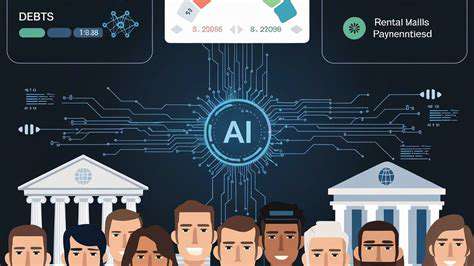Traditional Credit Scoring: Historical Context and Methodology
For generations, financial institutions have relied on conventional credit scoring models to evaluate borrowers. These systems primarily analyze past financial behaviors like credit card payments and loan repayments. While this approach has served as the backbone of lending decisions for decades, its effectiveness is now being questioned in our rapidly evolving financial ecosystem. Modern consumers engage in diverse financial activities that often fall outside traditional tracking methods, creating significant gaps in assessment accuracy.
Data Bias and Discrimination: A Significant Shortcoming
One glaring issue with conventional scoring models is their tendency to reinforce existing societal inequities. The historical data powering these systems frequently mirrors past discriminatory practices, disproportionately affecting marginalized groups. Consider a small business owner who relies on community lending circles rather than traditional banking - their creditworthiness might be systematically undervalued despite sound financial practices. Additionally, these models struggle to account for modern economic realities like gig economy income or temporary employment gaps.
Limited Scope and Lack of Adaptability
The financial world has transformed dramatically in the digital age, yet many scoring systems remain stuck in outdated paradigms. They often overlook crucial indicators like cryptocurrency holdings, peer-to-peer lending activity, or even consistent utility payments. This rigidity creates significant barriers for financially responsible individuals who don't fit the traditional borrower profile. A freelancer with fluctuating monthly income might demonstrate perfect payment discipline, yet struggle to secure favorable loan terms.
Inability to Capture Complex Financial Behaviors
Today's consumers interact with money in ways unimaginable when traditional scoring models were designed. From micro-investment apps to digital wallet usage, these complex behaviors defy simple categorization. Conventional systems frequently misinterpret or entirely miss these patterns, leading to potentially flawed assessments. Someone might maintain excellent financial health through alternative channels while appearing risky in traditional metrics.
Over-Reliance on Historical Data and Limited Predictive Power
Traditional models place excessive weight on past behavior, often at the expense of recognizing emerging positive trends. This creates particular challenges for young adults or recent immigrants building their financial histories. A college graduate with limited credit history but strong savings patterns might be unfairly penalized by systems prioritizing longevity over current financial responsibility.
Integration Challenges with Emerging Financial Products
The explosion of fintech innovations has dramatically outpaced the ability of conventional systems to adapt. Buy-now-pay-later services, digital lending platforms, and cryptocurrency transactions all represent legitimate financial activities that traditional models struggle to evaluate. This disconnect creates friction in the lending process and denies creditworthy individuals access to capital.
Computational Limitations and Scalability Issues
As global credit markets expand, traditional systems face mounting challenges processing ever-growing datasets. The manual adjustments required to maintain accuracy become increasingly cumbersome. These technical constraints highlight the urgent need for more sophisticated, adaptable approaches to credit evaluation.
AI's Transformative Impact on Credit Scoring

AI's Role in Credit Scoring
Modern artificial intelligence solutions are redefining credit assessment by analyzing thousands of unconventional data points. By examining patterns in mobile payment history, subscription service usage, and even educational background, AI creates multidimensional financial profiles far beyond traditional reports. This approach helps lenders identify creditworthy individuals previously invisible to conventional systems, like gig workers with consistent earnings but sparse credit histories.
Improving Fraud Detection
AI systems excel at identifying subtle, complex fraud patterns across massive datasets. Where human analysts might miss connections between seemingly unrelated transactions, machine learning algorithms detect anomalies with remarkable precision. This capability allows financial institutions to prevent fraud in real-time, protecting both lenders and borrowers from financial harm.
Automating Loan Application Processing
The loan approval process traditionally involved weeks of manual verification and analysis. AI-driven systems can complete these assessments in minutes by automatically validating documents, cross-referencing data sources, and applying complex risk models. This efficiency revolution benefits both lenders through reduced operational costs and borrowers through faster access to funds.
Personalized Financial Advice
Beyond credit decisions, AI enables hyper-personalized financial guidance. By analyzing spending habits, income patterns, and life circumstances, these systems can recommend tailored strategies for debt management, savings, and credit building. This represents a fundamental shift from one-size-fits-all financial products to customized solutions.
Enhanced Risk Management
AI-powered risk assessment considers hundreds of variables simultaneously, including macroeconomic trends and industry-specific factors. This comprehensive approach helps lenders make more informed decisions while maintaining healthy portfolios. During economic downturns, these systems can dynamically adjust risk parameters based on real-time data.
Customer Service Improvements
AI-driven interfaces provide instant, accurate responses to borrower inquiries around the clock. Natural language processing allows these systems to understand complex questions about loan terms, payment options, and credit implications. This 24/7 availability significantly enhances customer experience while reducing operational burdens on financial institutions.
Ethical Considerations and Responsible AI in Credit
As AI assumes greater responsibility in credit decisions, maintaining transparency and fairness becomes paramount. Financial institutions must implement rigorous testing to identify and eliminate algorithmic bias. Regular audits of decision patterns across demographic groups help ensure equitable treatment for all applicants, building trust in these advanced systems.
Enhanced Speed and Efficiency in Loan Approvals

Optimizing Core Processes
Modern lending platforms leverage automation to streamline previously manual-intensive tasks. Document verification, income validation, and risk assessment now occur in parallel rather than sequential steps. This holistic process redesign reduces approval times from weeks to hours while improving accuracy through systematic cross-checking.
Improved Communication Channels
Integrated communication systems keep borrowers informed at every approval stage. Automated status updates via preferred channels (email, SMS, app notifications) eliminate uncertainty and reduce customer service inquiries. Lenders benefit from standardized messaging that ensures regulatory compliance while maintaining personalization.
Enhanced Data Management Practices
Unified data platforms eliminate redundant information requests by securely storing and sharing verified documents. When a borrower applies for additional products, the system automatically retrieves previously submitted information, creating a seamless experience. This approach significantly reduces application fatigue while improving data accuracy.
Strategic Resource Allocation
AI-driven workflow systems dynamically assign underwriting tasks based on complexity and specialist availability. Simple applications route through automated channels, while complex cases receive targeted human attention. This intelligent distribution of resources maximizes both efficiency and decision quality across the loan portfolio.
Employee Training and Development
As technology assumes routine tasks, lending professionals focus on complex cases requiring human judgment. Ongoing training ensures staff develop the analytical and interpersonal skills needed for high-value interactions. This evolution creates more rewarding roles while improving overall service quality.
Leveraging Technology
Cloud-based platforms enable real-time collaboration between borrowers, lenders, and third-party verifiers. Advanced analytics provide loan officers with actionable insights during customer conversations. This technological integration creates a frictionless experience that benefits all stakeholders in the lending process.
Customer-Centric Approach
Modern systems design the approval process around borrower convenience rather than institutional requirements. Features like document upload via mobile cameras, electronic signatures, and real-time approval estimates reflect this orientation. The result is higher completion rates and improved customer satisfaction metrics.
Addressing Bias and Promoting Fairness in Lending
Understanding Bias in Traditional Lending
Historical lending patterns often institutionalized discrimination through seemingly neutral criteria. ZIP code-based assessments, for example, could inadvertently redline certain neighborhoods. Modern analysis reveals how these practices created systemic barriers for entire communities. Recognizing these patterns is the first step toward building more equitable alternatives.
AI's Potential for Bias Mitigation
When carefully designed, AI systems can actually reduce discrimination by focusing on predictive behaviors rather than demographic proxies. Alternative data like rental payment history or educational attainment might better indicate creditworthiness than traditional metrics in underserved communities. The key lies in intentionally designing systems that identify positive financial behaviors regardless of their form.
Fairness Metrics and Evaluation in AI Lending
Advanced fairness testing examines approval rates, interest rates, and default rates across demographic groups. Statistical techniques ensure models don't create or perpetuate disparities. Regular stress testing with synthetic data helps identify potential bias before it affects real applicants.
The Role of Transparency and Explainability
Modern AI systems provide clear explanations for credit decisions in consumer-friendly language. Rather than opaque algorithmic black boxes, these systems identify the specific factors influencing each decision. This transparency builds trust while allowing borrowers to understand and improve their credit profiles.
The Future of AI-Driven Credit Scoring: A Dynamic and Evolving Landscape
AI's Growing Role in Credit Risk Assessment
Next-generation credit models will incorporate dynamic, real-time data streams rather than periodic snapshots. Continuous updates from verified financial apps could provide more accurate current pictures than traditional monthly reports. This shift toward living credit assessments promises greater accuracy and responsiveness.
Enhanced Data Analysis for Predictive Accuracy
Future systems may analyze behavioral patterns like financial planning activities or career development investments as credit indicators. These forward-looking metrics could prove more meaningful than traditional backward-looking assessments, especially for younger borrowers.
The Impact on Underserved Communities
Innovative scoring approaches have already begun expanding access in developing markets. Mobile money usage patterns, merchant payment histories, and community reputation systems demonstrate how alternative data can build financial identity. These models show particular promise for populations excluded from traditional banking systems.
Addressing Ethical Concerns and Bias Mitigation
The industry is developing sophisticated tools to detect and correct algorithmic bias. Techniques like adversarial debiasing and fairness constraints actively prevent models from developing discriminatory patterns. Regular third-party audits will likely become standard practice for validated fairness.
The Future of Lending and Financial Inclusion
As AI systems mature, we'll see more personalized credit products adapting to individual circumstances. Dynamic credit limits, flexible repayment options, and proactive financial health monitoring could become standard features. This evolution promises to make credit more accessible while reducing risks for lenders.
Technological Advancements and the Role of Data Security
Emerging privacy-preserving technologies like federated learning allow credit modeling without centralized data collection. Blockchain-based credential verification could reduce fraud while giving consumers more control over their financial data. These innovations aim to balance innovation with rigorous security standards.
